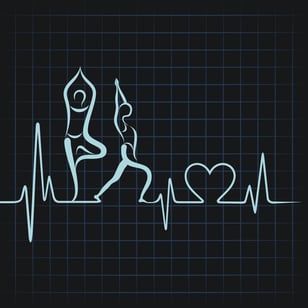Throughout 2015, we’ll be blogging about our dreams for corporate wellness, fitness, and aging well. Some of the content will represent a gentle “poking fun” at the industry, but it’s all written to stimulate thought about what really could be if we put our heads together and started mapping out what’s really possible in the realm of individual wellbeing. We hope you’ll join the conversation by commenting on the blogs, giving us additional ideas about which to write, or by finding us out on Twitter at #wellnesswhatif.
To build this “What If” series of blogs, I polled our staff about their desires and dreams for their members and clients, and I have to admit, I was a little surprised that so many of our staff gave me feedback about building a corporate fitness center that their members could visit without guilt and intimidation. Apparently corporate shaming is still alive and well, and we as health and fitness professionals have a long way to go toward building member confidence in the fitness center.
So for this blog I’m going to run through the things that lead to perceptions of guilt as well as what we can do to build corporate environments that support the individual who takes care of his health. I’ll also be breaking down that intimidation factor to look at ways we can provide better support to our less confident members.
 Management Doesn’t Support Staff Taking Their Break Time to Work Out
Management Doesn’t Support Staff Taking Their Break Time to Work Out
Somehow, we still have managers who think that butts in the seats all day long is the best way to get employees to be productive. Science would tell us otherwise, and I offered three different studies on this very topic in an earlier blog (3 Reasons to Add a Corporate Fitness Center to Your Wellness Program).
I understand there are quotas to be met, and I’m not saying companies should throw those to the wind. Absolutely, the business runs on meeting those goals, and no, the goals can’t be met when employees are working out and not working. But there’s a break point, for all of us (yes, even for you), where we start to lose focus and where we no longer do our best work. The managers who are still looking down their noses at employees who need an activity break should ask themselves which employee is a more effective partner in reaching the quota:
- An employee who stays put and decreases in effectiveness throughout the course of the day, or
- The employee who takes the company-allowed break to clear his head while lifting weights or walking on the treadmill and returns to his seat refreshed and ready to continue working?
Businesses have very little policy in place on how an employee uses a designated lunch or other break time, so why would management offer disdain for the employee who chooses to take a group fitness class at lunch?
And here’s the other consequence of unsupportive management: Not only do employees feel guilty for using their time (yes, it’s their time) that way, but they realize that maintaining good health is not important to their boss. Thus it becomes increasingly difficult for the employee to keep that as a personal and professional priority.
So how do we turn this cultural challenge around? I wish I had all the right answers. But I think the fixes for this situation are as unique as the client environment, and your ability to nudge this kind of change requires creativity and tremendous amounts of persistence. Cultural change is indeed slow, and very hard. But when an organization figures out its priorities for the business, and they include supporting wellbeing for the employees, you have a lot of opportunity to creatively help individuals move more.
We worked hard in one client setting with a high percentage of call-center employees to turn around middle management’s image that the employees absolutely and without exception HAD to be on the phones. Through a program that, ironically, was not based in their corporate fitness center, we were able to help employees get up and moving on a more regular basis. In fact, in the first four months of this program, 33 percent more participants reported walking at work at least five times per week. We had such fantastic results with this program, we wrote an eBook about it called The Cure for Sitting Disease.
Employees Who Most Need to Use the Corporate Fitness Center Are Often the Most Intimidated by It
This intimidation issue is at the heart of what NIFS does. We’re a fitness center management organization that specializes in placing amazing staff in our clients’ corporate fitness centers to run the operation. The first step to breaking down a barrier of intimidation is having the right people on board to assist any of your employees. Your fitness staff needs to possess a unique blend of compassion and desire to work with everyone, along with technical expertise for prescribing and teaching exercise.

And then, with the right motivated fitness specialists in your fitness center, you can start to build programs that work. Personal Fitness Quest is a positive example of such a program opportunity geared toward individual members who need the most support. We call it our alternative to personal training, and it continues to be one of the most popular offerings we have across our client sites. Skeletone is another successful program, though unlike Personal Fitness Quest, it’s geared more toward the whole membership audience as we set up stepwise inspiration for them to be more active in the fitness center. For the duration of this program, we increased monthly visits by 23 percent over the previous month and saw a whopping 40 percent increase in active members who attended the fitness center at least eight times or more compared with the preceding month.
Another strategy for overcoming the intimidation issue is to understand it better, and surveys can be a helpful information-gathering tool for this purpose. Sometimes, members will simply offer their feedback, but you probably have a whole crew of employees who haven’t come through the doors in a while (some of whom stay away because they feel intimidated) and who aren’t likely to walk right in offering why they’ve stayed clear of the fitness center. Surveys—when used carefully—can be a great tool for continuous feedback about areas for improvement.
Guilt and intimidation aren’t easy issues to tackle, but they clearly get in the way of employees’ success with exercising regularly at work. What have you tried with success at your office to break down these typical barriers? I’d love to hear about your experiences with these concepts (personally and professionally) because we can all learn and do better with dialog that is truthful and solution-based.
 Businesses need top performers in order to survive. We need sales staff who are heavy hitters, research staff who are actually rocket scientists, and customer service professionals who can turn any frown upside down. You know who those folks are in your organization, that top 5% of all performers. In some cases, they might be unsung heroes, but at a lot of businesses, the best among us are often publically lauded. They are the elite.
Businesses need top performers in order to survive. We need sales staff who are heavy hitters, research staff who are actually rocket scientists, and customer service professionals who can turn any frown upside down. You know who those folks are in your organization, that top 5% of all performers. In some cases, they might be unsung heroes, but at a lot of businesses, the best among us are often publically lauded. They are the elite.

 According to a study published in the
According to a study published in the 

 You’ve heard the saying, “it takes a village to raise a child”, right? The idea is that a child needs a whole village worth of support an influence, and education, and diversity to be raised into a healthy and vibrant member of society. If we look at individual wellbeing through a similar lens, I would say that it takes a team to help an individual be well.
You’ve heard the saying, “it takes a village to raise a child”, right? The idea is that a child needs a whole village worth of support an influence, and education, and diversity to be raised into a healthy and vibrant member of society. If we look at individual wellbeing through a similar lens, I would say that it takes a team to help an individual be well.  We do a lot of wellness consulting in senior living, and by “wellness”, I mean non-clinical, lifestyle-focused consulting. For many of our clients, that consulting relationship involves a thorough review of their “activities” department; in other cases, it’s focused more on what’s happening with their exercise program. Regardless of the original area of focus, we always arrive at the same point – building a strategy that allows the community to shift from filling a calendar toward supporting resident purpose and passion.
We do a lot of wellness consulting in senior living, and by “wellness”, I mean non-clinical, lifestyle-focused consulting. For many of our clients, that consulting relationship involves a thorough review of their “activities” department; in other cases, it’s focused more on what’s happening with their exercise program. Regardless of the original area of focus, we always arrive at the same point – building a strategy that allows the community to shift from filling a calendar toward supporting resident purpose and passion.

 Management Doesn’t Support Staff Taking Their Break Time to Work Out
Management Doesn’t Support Staff Taking Their Break Time to Work Out

